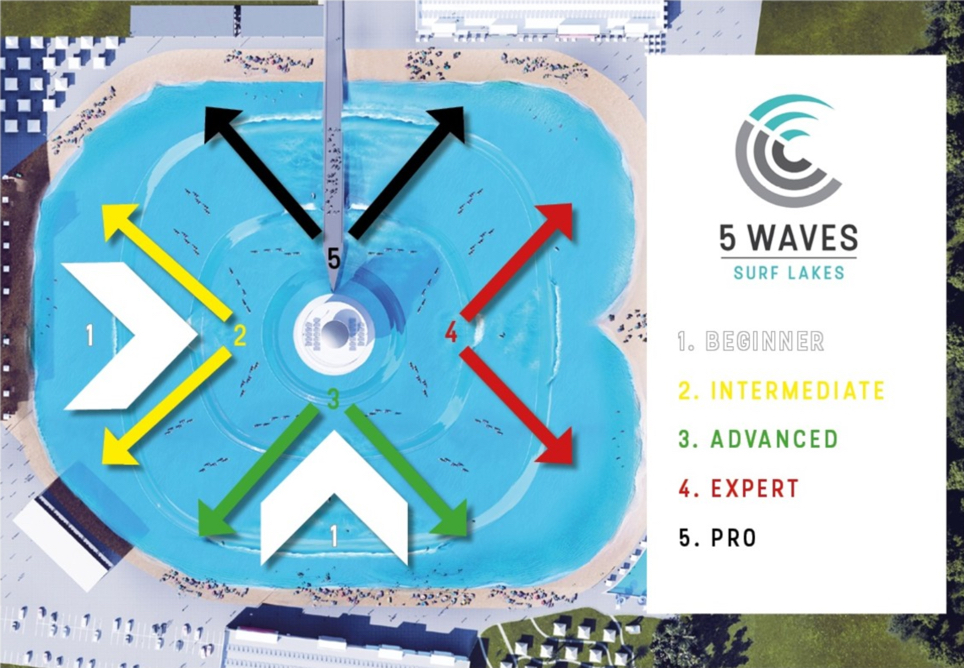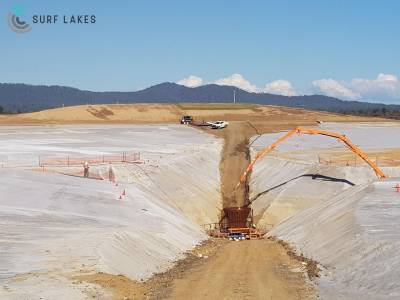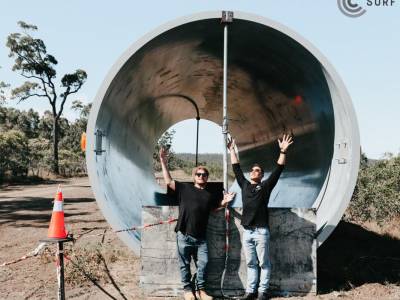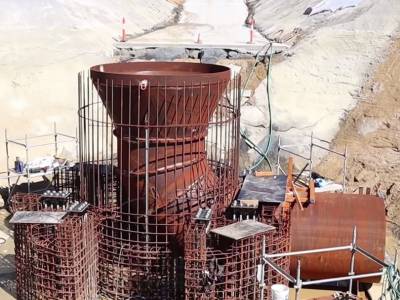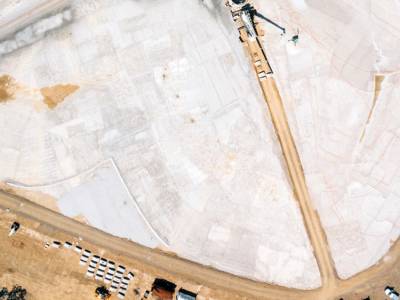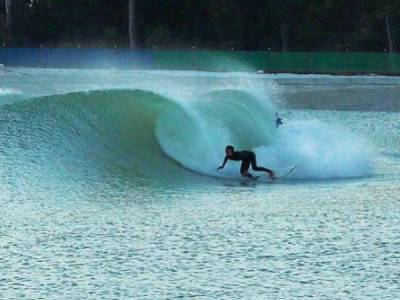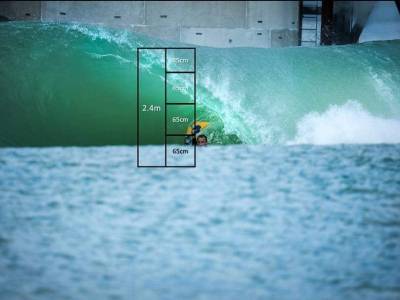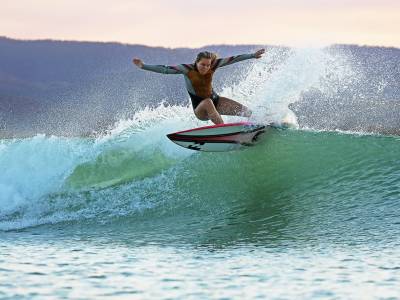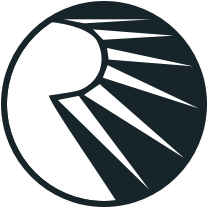Surf Lakes 5 Waves
Surf Lakes 5 Waves Technology
The 5 Waves technology from Surf Lakes generates waves by moving a device that resembles a plunger up and down in the center of a pool. This motion creates concentric circular swells that radiate out from the center of the pool to various surf breaks around the perimeter of the lake. Variations in the bathymetry (bottom contours) allow different breaks around the pool to have different characteristics, so one swell can actually create up to five different waves, hence the name: 5 Waves. And, as seen in the Surf Lakes prototype, many of those waves will offer a left and right break. So, in their standard commercial installation that includes four peaks plus one or two inside beginner breaks, you get eight rides generated per swell plus a few beginners riding whitewater.
The shape and bathymetry of the lagoon can be customized to meet customers’ needs, which could result in more or less breaks.
Read More
The central wave device (CWD) in the center of the pool, which weighs 1400 tons at the prototype pool in Yeppoon, is moved up and down by air pressure. The up-down cycle is repeated 4-7 times to create sets of 3-6 waves. The CWD moves up and down in a 4.2 – 5.5 meter stoke. A bigger stroke results in bigger waves.
The vertical piston approach to wave-making has minimal friction and negligible lateral forces, which hypothetically could mean reduced maintenance.
The timing of the up-down cycles is critical for multiple reasons: energy recovery, wave shape/size and mechanical tolerances. With properly timed cycles, the plunger’s up and down movement can be harmonized with water displacement, essentially allowing water pressure to help raise the plunger back up after it presses down to create the swell. This allows the Surf Lakes team to recover 60% of the energy from one cycle and use it on the subsequent cycle. Proper timing also allows the Surf Lakes technology to create waves that start with a trough and have the circular particle motion that is seen in ocean waves. The timing also means the waves increase in size over the course of a set, e.g. the third wave is bigger than second and first. Lastly, improper timing can cause problems like the broken “conrod" incident from the first round of prototype testing.
The Pool
Commercial installations will require 2.5-3.5 hectares (6-8.5 acres) for the pool. That would make Surf Lakes installations some of the biggest surf pools on the planet. When you add shoreline space for surrounding amenities, the total land area for a commercial installation is expected to be 6-8 hectares (15-20 acres).
The pool is lined with concrete. The depth and bottom contours depend on the waves desired by the developer. The standard commercial installation will include four peaks: 2 similar to “Occy’s Peak" at the prototype and 2 similar to the “Beach Break" which resembles Lowers in Southern California.
The edge of the pool has gutters that capture some of the wave energy to help reduce turbulence and settling time.
The pool can be filled with fresh water or salt water. Depending on size they expect the pools to hold 60-80 megaliters of water. The prototype in Yeppoon holds 80 megalitres.
Wave Characteristics in Surf Lakes Pools
Surf Lakes 5 Waves technology creates a variety of waves by varying the bottom contours around the edge of the pool. Like waves in the ocean, when waves generated by Surf Lakes encounter an abrupt decrease in depth, they tend to barrel. If waves encounter a gradual decrease in depth, they tend to be softer and more playful. Surf Lakes designs the contours of the bottom of the pool to create a variety of distinct waves around the edge of the pool.
The prototype pool has proven that the Surf Lakes 5 Waves technology is capable of creating heavy slab-like barrels and ripable walls. They are confident that they can also create intermediate waves and gentle whitewater rollers for beginners.
The size of the waves generated by Surf Lakes technology also varies around the pool based on bathymetry and proximity to the plunger. Waves that break closer to the plunger are bigger and more powerful, while waves further away are smaller and more suitable for less skilled surfers. At the prototype pool in Yeppoon the biggest waves are up to 8 feet (2.4m) on the face.
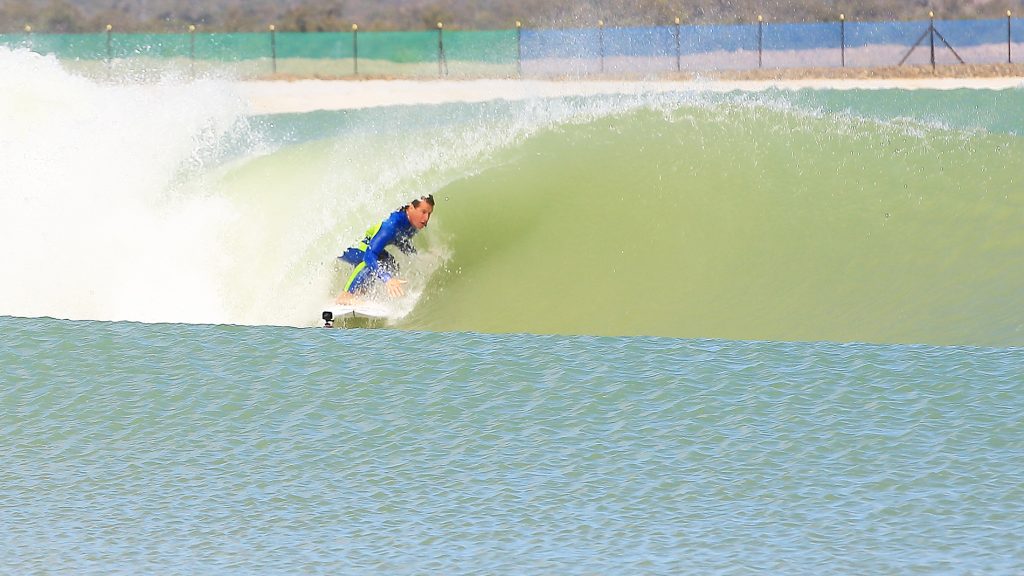
Controlling Surf Lakes Pools
The size and shape of the waves in a Surf Lakes wave pool is primarily dependent on the stroke size (i.e. how far the CWD moves up and down) and the bottom contours. However, Surf Lakes can also use the speed of the CWD movement to control wave shape. For example, a slower CWD descent results in softer waves.
Frequency and Capacity
The frequency of wave generation depends on how much time the operator allows for the water to settle, and settling time depends on the size of the wave created and the size of the pool. The Surf Lakes team is hoping to create 300 swells per hour, in 6-swell sets. Each swell will produce rides at each peak, so a pool like the prototype with four A-frame peaks will provide 8 rides per wave around the pool, not including beginners in the whitewater areas. That means Surf Lakes 5 Waves could be generating 2400 rides per hour. With anywhere from 100-240 surfers in the pool at a time, each surfer will get a chance to ride 10-20 waves per hour at a Surf Lakes 5 Waves facility.
The length of ride on the waves in a Surf Lakes 5 Waves pool will also depend on the design of the bottom contours and the size of the lake. The waves at the prototype pool in Yeppoon can be ridden for 10-15 seconds, including 7-second barrels. The Surf Lakes team expects similar numbers at commercial facilities, with longer rides potentially for those surfing the Beach Break.
The Surf Lakes 5 Waves technology will also be able to produce whitewater rollers that are ideal for beginners learning the basics of surfing.
Wave Pools Powered by Surf Lakes 5 Waves Technology
Highlights and Lowlights
| Waves are most similar to those found in the ocean. | |
| Beach on all sides of the lagoon. | |
| Supports the most simultaneous surfers. |
| Huge pool footprint | |
| Length of ride limitations. |

